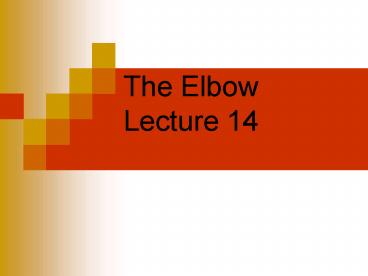The Elbow Lecture 14 PowerPoint PPT Presentation
1 / 28
Title: The Elbow Lecture 14
1
The ElbowLecture 14
2
The Elbow
- the elbow is second to the shoulder for
dislocations ( first in children ) and second to
the knee for overuse injuries.
3
Bony Structure of Elbow
- humeroulnar is the hinge joint , where the
trochlea of the humerous articulates with the
trochlera fossa of the ulna - the humeroradial joint is a gliding joint , here
the capitulum of the humerous articulates with
the radius
4
- the annular ligament binds the head of the radius
to the radial notch of the ulna forming the
proximal radioulnar joint this is a pivot joint
allowing for pronation and supination
5
- Carry Angle of the Elbow
- The angle between the long axes of the humerus
and the ulna when the arm is in an anatomical
position - This is called this because it allows the forearm
to angle away from the body when a load is
carried in the hand - Carrying angle is generally greater in females
than in males
6
(No Transcript)
7
Elbow Stability
- Medial Collateral
- a) anterior - strong reinforces annual lig.
- b) transverse - weaker
- c) posterior fibres
- Most important ligament in the elbow for
stability
8
- Lateral Collateral
- a) anterior
- b) intermediate
- c) posterior
- all help to reinforce the strong annular ligament
9
Elbow movements
- Flexion
- Extension
- Pronation
- Supination
10
Common Injuries
11
Elbow Dislocation / Subluxation
- ulnar dislocations
- hyperextension ( Fall on hand elbow extended)
with violent twisting action of the ulna , needs
a tremendous amount of force - more common displacement of radial head
especially in children , swinging of children by
their arms , may cause radial head to snap out of
the annular ligament
12
- severe pain with loss of function , cracking or
snapping sensation , rapid swelling and obvious
deformity , inability to move elbow - 90 posterior , management is important not to
cause long term disabilities
13
(No Transcript)
14
First Aid
- In case of dislocations a primary concern is not
to cause complications to the neurovascular
tissue - Apply ice and compression
- Splint on both sides of the injury and stabilize
as best as possible
15
(No Transcript)
16
Olecranon Bursitis
- the olecranon bursa is the largest bursa in the
elbow and sits just over the olecranon process - injury results due to a direct fall, constant
irritation, or infection
17
- an acutely inflamed bursa will rapidly swell,
show signs of redness and increased heat - often termed golf ball swelling
- the bursa may become infected again it will be
swollen and hot to touch along with a possible
fever , pain , tenderness and restricted range of
motion, refer to Dr immediately if infected - Rx PIER protection, aspiration may be
necessary
18
(No Transcript)
19
(No Transcript)
20
Elbow strain
- usually the result if someone attempting to
overcome large force with muscle - inadequate warm-up , excessive training (past
point of fatigue) - common with biceps brachii, brachiallis, triceps
- pain and point tenderness over the injury site,
reduced strength and ROM - Rx PIER , NSAIDS .. strengthening
21
Elbow Sprain
- usually the result of fall on extended arm,
producing a hyperextension of elbow - or through a valgus/varus force
- may be due to a repetitive force that irritate or
tear the ligaments - pain , local tenderness . pain and or laxity with
stressing of the ligament, decreased ROM - Rx PIER , NSAIDS .. strengthening
22
Medial Epicondylitis
- aka little league elbow or golfers elbow
- repetitive motions with poor technique, muscular
weakness or anatomical weakness - often seen in the acceleration phase of throwing
23
- valgus force is placed on the elbow, which
strains the flexor muscle , the ulnar collateral
ligament and possibly the ulnar nerve. - swelling at the medial epicondyle, point
tenderness, pain on resisted wrist flexion and
pronation - tingling and numbness may be felt if the ulnar
nerve is involved - Rx- PIER , NSAIDS, bracing modalities retraining
24
Lateral Epicondylitis
- aka tennis elbow
- most common overuse injury in the elbow
- this condition is typically due to eccentric
overloading of the extensor muscles as seen in
the deceleration phase of throwing or the tennis
stroke - pain will be located on the lateral epicondyle ,
it may be swollen and the pain will increase with
resisted wrist extension - Rx- PIER , NSAIDS, bracing , retraining
25
- Contributing factors to tennis elbow
- lack of experience
- missing "sweet spot" poor technique on backhand
- heavy stiff racquet ( 12 - 12.5 seem to be best)
- grip size
- racquet strings to tight( 2-3 lbs. best)
- playing surface ( ball bounces more off cement)
26
(No Transcript)
27
Cubital Tunnel Syndrome
- impingement of ulnar nerve in cubital tunnel of
the elbow ( through ulnar groove and under the
ulnar ligament) - here the nerve is vulnerable to compression and
tensile stress caused by trauma
28
- sharp pain along medial aspect forearm, tingling
and numbness into ring and little finger of hand - signs and symptoms reproduced by tapping over
ulnar groove - Rx- depending on severity should be referred to
doctor watch icing of a nerve

